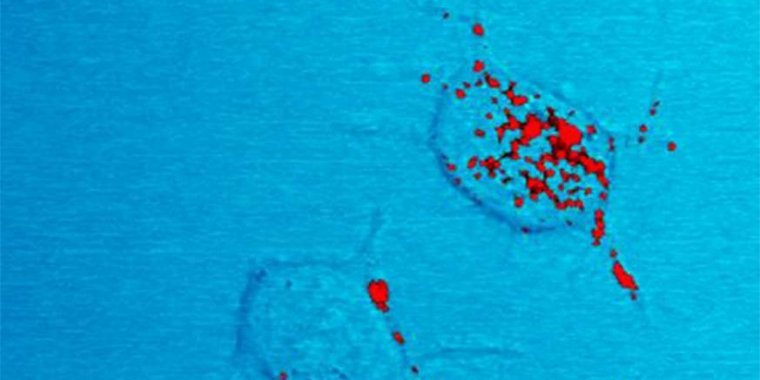| Health / Health News |
Experimental treatment slows prion disease, extends life of mice
Scientists using an experimental treatment have slowed the progression of scrapie, a degenerative central nervous disease caused by prions, in laboratory mice and greatly extended the rodents’ lives. The scientists used antisense oligonucleotides (ASOs), synthetic compounds that inhibit the formation of specific proteins.

Prion protein, shown in red, can become infectious and cause neurodegenerative disease. Here four nerve cells in a mouse illustrate how infectious prion protein moves within cells along neurites – wire-like connections the nerve cells use for communicating with adjacent cells. Photo: NIAID
Prion diseases occur when normally harmless prion protein molecules become abnormal and gather in clusters and filaments in the body, including the brain. The diseases are thought to be always fatal. Scrapie, which affects sheep and goats and can be adapted to rodents, is closely related to human prion diseases such as Creutzfeldt-Jakob disease, which is currently untreatable. Thus, scrapie is a valuable experimental model for the development of human prion disease therapies.
In the studies, scientists injected ASOs into the spinal fluid of mice already infected with scrapie or that were challenged with scrapie proteins within weeks of the injection. Ionis Pharmaceuticals specifically designed ASO1 and ASO2 to reduce the rodents’ supply of normal prion protein.
RML scientists injected either ASO1 or ASO2 into mice 14 days prior to infecting them with scrapie, and then seven or 15 weeks after infection. Mice treated with ASO1 did not show clinical signs of disease for a median 250 days, or 82% longer than untreated mice (137 days), and they lived 81% longer than untreated mice (259 days versus 143 days).
Mice treated with ASO2 did not show clinical signs of disease for a median 272 days, or 99% longer than untreated mice (137 days), and they lived 98% longer than untreated mice (283 days versus 143 days).
In the Broad Institute experiments, mice received either ASO1 or ASO2 2 weeks before infection with scrapie and then seven weeks after infection. Both ASOs delayed rodent weight loss. Mice treated with ASO1 and ASO2 both lived longer than untreated mice, by 61% (274 days versus 170 days) and 76% (300 days versus 170 days), respectively.
The RML group also tested the ASOs against established prion disease, treating mice 17 weeks after they were infected with scrapie – near the onset of clinical signs. Mice treated with ASO1 did not show signs of clinical disease for a median 189 days, or 33% longer than untreated mice (142 days).
They also showed slower disease progression and lived 55% longer than untreated mice (244 days versus 157 days). ASO2 had no beneficial effect. (National Institutes of Health)
YOU MAY ALSO LIKE



